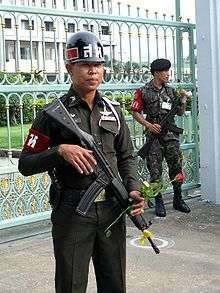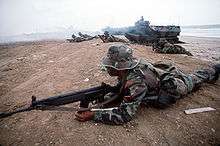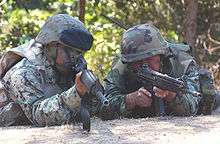Heckler & Koch HK33
| Heckler & Koch HK33 | |
|---|---|
|
| |
| Type | Assault rifle |
| Place of origin | West Germany |
| Service history | |
| In service | 1968–present |
| Used by | See Users |
| Production history | |
| Manufacturer | Heckler & Koch, MAS (licensed), MKEK(licensed) |
| Variants | See Variants |
| Specifications | |
| Weight |
HK33A2: 3.65 kg (8.05 lb) HK33A3: 3.98 kg (8.8 lb) KH33KA3: 3.89 kg (8.6 lb) HK53: 3.05 kg (6.7 lb) |
| Length |
HK33A2: 920 mm (36.2 in) HK33A3: 940 mm (37.0 in) stock extended / 735 mm (28.9 in) stock collapsed HK33KA3: 865 mm (34.1 in) stock extended / 675 mm (26.6 in) stock collapsed HK53: 755 mm (29.7 in) stock extended / 563 mm (22.2 in) stock collapsed |
| Barrel length |
HK33A2: 390 mm (15.4 in) HK33KA3: 332 mm (13.1 in) HK53: 211 mm (8.3 in) |
|
| |
| Cartridge | 5.56×45mm NATO |
| Caliber | 5.56mm |
| Action | Roller-delayed blowback |
| Rate of fire |
HK33A2: 750 rounds/min HK53: 700 rounds/min |
| Muzzle velocity |
HK33A2: 950 m/s (3,117 ft/s) HK33KA3: 880 m/s (2,887.1 ft/s) HK53: 750 m/s (2,460.6 ft/s) |
| Effective firing range | 100–400 m (328–1,312 ft) sight adjustments |
| Feed system | 25-, 30-, or 40-round detachable box magazine |
| Sights | Rotary rear aperture drum, hooded foresight |
The HK33 is a 5.56mm assault rifle developed in the 1960s by West German armament manufacturer Heckler & Koch GmbH (H&K), primarily for export.
Capitalizing on the success of their G3 design, the company developed a family of small arms (all using the G3 operating principle and basic design concept) consisting of four types of firearms: the first type, chambered in 7.62×51mm NATO, the second—using the Soviet 7.62×39mm M43 round, third—the intermediate 5.56×45mm caliber and the fourth type—chambered for the 9×19mm Parabellum pistol cartridge.
The HK33 series of rifles were adopted by the Brazilian Air Force (Força Aérea Brasileira or FAB), the armed forces of Thailand and Malaysia where they were produced under a license agreement. The rifle was also license-built in France by MAS and in Turkey by MKEK.
Design details

Operating mechanism
The HK33 is a selective fire weapon with Heckler & Koch's roller-delayed blowback system of operation. It employs a two-piece bolt consisting of a bolt head with a pair of rollers and bolt carrier. Upon firing, the two cylindrical rollers in the bolt head are cammed inward by inclined surfaces of the barrel extension and impart a rearward motion on the locking piece, which also propels the bolt carrier rearward. This built-in mechanical disadvantage delays the movement of the bolt head relative to the bolt carrier which is withdrawing at four times the velocity of the bolt. The rollers soon compress entirely into the bolt head, clearing the locking recesses of the barrel extension, and both parts now continue rearward together, opening the breech and actuating the extraction and feeding cycles. The chamber is opened under very high pressure, thus the chamber received a series of flutes in order to increase extraction reliability and prevent sticking of the spent casing to the chamber walls.
Features
The bolt also contains a spring extractor, an anti-bounce device (that prevents the bolt from being deflected after impacting the barrel breech) and a buffer. The ejector lever was installed in the trigger housing and is actuated by the recoiling bolt.
The HK33 has a conventional hammer-type firing mechanism. In the standard version, the rifle comes equipped with an ambidextrous trigger group with a selector lever that is simultaneously the weapon's safety (it has three positions: "S" or "0"—weapon is safe, "E"/"1"—semiautomatic fire, "F"/"25"—continuous fire). The "safe" setting mechanically disables the trigger. The trigger groups can be swapped out to meet the user's specific mission requirements. H&K offers several different trigger assemblies: a three-shot burst fire control group with selector lever/safety (selector settings: "0"—weapon is safe, "1"—single fire, "2"—2-round burst or "3"—burst, 3-rounds; the selector lever is ambidextrous); a "Navy" trigger unit (three settings: safe, semi and full auto fire) and a four-position trigger group (selector settings: safe, single fire, 3-round burst and automatic fire).
The rifle is fed from 25-round steel magazines weighing 250 g or 40-round aluminum magazines (weighing 157 g). 30-round arch magazines were also introduced for use with the rifle.
The barrel is equipped with a slotted flash suppressor that enables the use of rifle grenades and supports a standard G3-type bayonet that mounts above the barrel.
During its production life the rifle received several minor improvements (these modified weapons are sometimes referred to collectively as the HK33E). The fixed stock was strengthened and the synthetic forearm replaced with a handguard that allows a lightweight bipod to be attached and stowed into two grooves at the base. The shoulder pad in rifles fitted with a telescopic stock was changed to a concave type used thus far in the MP5 series. Initially the rifle was produced with a 305 mm (1:12 in) twist rate barrel, which was later upgraded to the faster 178 mm (1:7 in) twist rate (used to stabilize new, heavier NATO-standard SS109/M855 ammunition).
The rifle is disassembled into the following components for maintenance: the receiver, stock with return spring, bolt assembly and trigger pack with pistol grip.
Sights
The weapon is aimed using adjustable iron sights with a rotating rear drum (corrected mechanically for windage and elevation) that contains an open square notch used for immediate firing at 100 m and three apertures for 200, 300 and 400 m. The receiver top cover has a series of notches designed to accept a clamping mount (standard with the HK33, G3, G3SG/1 and MP5) for use with optical sights (typically the Hensoldt 4×24 scope) or a night vision device.
Accessories
Included with the rifle are a detachable bipod, bayonet (from the G3), sling, cleaning kit and a magazine loader. Additionally, the HK33 can be used to mount a 40 mm under-barrel HK79 grenade launcher or a blank-firing adaptor.
Variants
- HK33A2
- Variant with a rigid synthetic stock.
- HK33SG/1
- An accurized model; equipped with a telescopic sight and improved trigger analogous to the one used in the G3SG/1.
- HK33A3
- Standard rifle but with telescoping metal stock.
- HK33KA3
- Carbine version with barrel reduced in length to the base of the front sight post; also equipped with a folding metal stock. Due to the short barrel, the HK33KA3 cannot be used to launch rifle grenades or mount a bayonet.
- HK53
- Compact version of the HK33K. Has a short, 211 mm barrel, a forearm derived from the MP5 submachine gun and a telescopic shoulder stock or receiver endplate cover (later models also received a four-prong flash hider).
- HK13
- Light machine gun. It is fed from either box or drum magazines (the latter has a 100-round capacity), has a quick-change heavy barrel for sustained fire, shrouded with a sheet metal heat guard (replacing the synthetic forearm) and a 2-point bipod adapter.
- Type 11
- A derivative of the HK33 manufactured in Thailand by the Ministry of National Defence for use by the Thai armed forces. A bullpup variant also exists with M16 sights and foregrip for close combat in jungle environments.[1]
Sporting variants
Heckler & Koch also manufactured a semi-automatic only variant of the HK33A2 for the civilian shooting market designated the HK93A2 Also available in a retractable stock version with the designation HK93A3.
- C-93
- Civilian semi-automatic sporting version produced by Century International Arms, Inc. It comes with an 18.9 or 16.25-inch (413 mm) barrel with a 1:9 twist ratio. A carrying handle and 40-round magazine are standard. Advertised weight is 8.2 lbs. The C-93 is built from Thai Type-11 parts kits using an American made barrel and other miscellaneous American parts.
Users


 Argentina: HK33.
Argentina: HK33. Brazil: HK33E variant.[2]
Brazil: HK33E variant.[2] Chile: HK33 variant.[2] Being replaced by FN SCAR-L/H[3]
Chile: HK33 variant.[2] Being replaced by FN SCAR-L/H[3] Ecuador: HK33 variant.[2]
Ecuador: HK33 variant.[2] El Salvador: HK33 variant.[2]
El Salvador: HK33 variant.[2] Germany: HK53 variant.[2]
Germany: HK53 variant.[2] Ghana: HK33 variant.[2]
Ghana: HK33 variant.[2] Greece: HK33E variant.[2]
Greece: HK33E variant.[2] Guatemala: HK33 variant.[2]
Guatemala: HK33 variant.[2] Indonesia: HK53 variant is used by Komando Pasukan Katak (Kopaska) tactical diver group and Komando Pasukan Khusus (Kopassus) special forces group.[4]
Indonesia: HK53 variant is used by Komando Pasukan Katak (Kopaska) tactical diver group and Komando Pasukan Khusus (Kopassus) special forces group.[4] Iran: HK53 variant.[2]
Iran: HK53 variant.[2] Ireland: HK33E variant; Army Ranger Wing, Garda Emergency Response Unit[2][5]
Ireland: HK33E variant; Army Ranger Wing, Garda Emergency Response Unit[2][5] Luxembourg: The HK53 carbine variant is used by the Unité Spéciale de la Police intervention unit of the Grand Ducal Police.[6]
Luxembourg: The HK53 carbine variant is used by the Unité Spéciale de la Police intervention unit of the Grand Ducal Police.[6] Malaysia: HK33E variant.[2]
Malaysia: HK33E variant.[2] Myanmar: HK33E variant.[2]
Myanmar: HK33E variant.[2] Mexico: HK33E variant.[7]
Mexico: HK33E variant.[7] Netherlands: HK33 variant.[2]
Netherlands: HK33 variant.[2] Philippines:[8]
Philippines:[8] Portugal: HK33E variant.[2]
Portugal: HK33E variant.[2] Saudi Arabia: HK33E variant.[2]
Saudi Arabia: HK33E variant.[2] Senegal: HK53 variant.[2]
Senegal: HK53 variant.[2] Spain: GEO unit of the Spanish National Police.[9]
Spain: GEO unit of the Spanish National Police.[9] Thailand: HK33 variant.[2] Made under license as Type 11 rifle.
Thailand: HK33 variant.[2] Made under license as Type 11 rifle. Turkey: HK33E variant produced under licence by MKEK.[10]
Turkey: HK33E variant produced under licence by MKEK.[10] United States: HK53 variant is used by the US Border Patrol.[11]
United States: HK53 variant is used by the US Border Patrol.[11] United Kingdom: HK53 variant is used by Cumbria Constabulary's firearms unit.[12]
United Kingdom: HK53 variant is used by Cumbria Constabulary's firearms unit.[12] West Germany: HK33 variant was used extensively by police and security units.[13]
West Germany: HK33 variant was used extensively by police and security units.[13]
See also
Notes
- ↑ "Image of Hock Gun". I257.photobucket.com. Retrieved 2013-10-18.
- 1 2 3 4 5 6 7 8 9 10 11 12 13 14 15 16 17 Jones, Richard D. Jane's Infantry Weapons 2009/2010. Jane's Information Group; 35 edition (January 27, 2009). ISBN 978-0-7106-2869-5.
- ↑ Chile; Marines confirm SCAR 5.56mm rifles order - Dmilt.com, 2 August 2013
- ↑ "Kopassus & Kopaska - Specijalne Postrojbe Republike Indonezije" (in Croatian). Hrvatski Vojnik Magazine. Retrieved 2010-06-12.
- ↑ "Garda College Yearbook listing weapons training on page 66" (PDF).
- ↑ "Equipement :: Unité Spéciale de la Police ::". USP.LU. Retrieved 2013-10-18.
- ↑ Gander, Terry J.; Hogg, Ian V. Jane's Infantry Weapons 1995/1996. Jane's Information Group; 21 edition (May 1995). ISBN 978-0-7106-1241-0.
- ↑ "Rice Not Guns - German Arms in the Philippines". Retrieved 23 December 2014.
- ↑ Archived December 13, 2008, at the Wayback Machine.
- ↑ "MKEK - Makina ve Kimya Endüstrisi Kurumu". Retrieved 23 December 2014.
- ↑ "Guns of the United States Border Patrol". Human Events. Retrieved 2013-10-18.
- ↑ "North West Evening Mail - News - Cumbria police reveal arsenal to keep armed crime at bay". Retrieved 23 December 2014.
- ↑ "Modern Firearms - HK HK33 and HK53". World.guns.ru. Retrieved 2013-10-18.
References
- Woźniak, Ryszard (2001). "p. 105-107". Encyklopedia najnowszej broni palnej - tom 2 G-Ł (in Polish). Warsaw, Poland: Bellona. ISBN 83-11-09310-5.
External links
| Wikimedia Commons has media related to HK33. |
.jpg)